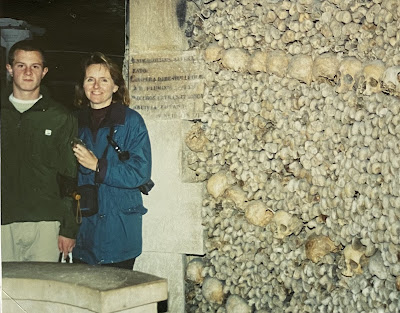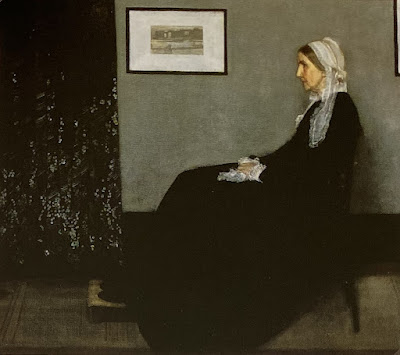December 26-27, 2000
Starting in 1786, wagons loaded with the remains of more than six million human bodies made their way through the streets of Paris at night, depositing their loads in a mine shaft that led to what used to be the city's underground stone quarries. Many of the remains came from overcrowded cemeteries in the city. At first the underground cemetery was a disorganized mess, but in 1810 the director of the Paris Mine Inspection Service oversaw the process of creating order out of chaos, stacking the bones and skulls in the patterns visitors see today and adding other interesting elements. It became a novelty gathering spot for private events in the early 19th century, and in 1874 it was opened for visitors.
And just 126 years later, the Cannon family from California walked down the spiral staircase into the depths of the Paris Catacombs.
It appears that the "organizers" tried to keep bones from different cemeteries separated. The sign on the left reads, "Bones from the old Magdeleine Cemetery deposited in 1844 in the west ossuary and transferred to the catacombs in September 1859."
The sign over our heads (left) says, "Stop! This is the empire of death." The sign behind our son (right) notes that these bones were taken from the St. Etienne Cemetery and re-interred here in 1787.
Since this experience with an ossuary (a room filled with human bones), we have been to several others, including one in
Kutna Hora (Czech Republic) and one in
Evora (Portugal), but there's nothing like the shock of the first time.
Back out in the cold but fresh air, our youngest son took this photo of a lion guarding the catacombs.
Our next stop was the Musée d'Orsay (Orsay Museum), a museum specializing in art from 1848 to 1914 and best known for its Impressionist and post-Impressionist collection, including Manet's Olympia and Monet's paintings of Rouen Cathedral and his gardens at Giverny. Of course, I wasn't into taking pictures of pictures back then. I did, however, buy this postcard of Whistler's Mother by the American artist James McNeill Whistler . . .
. . . and this postcard of Renoir's
La danse a la ville (Dancing in the City):
Of course, number one on MY list for What To See In Paris was the
Eiffel Tower, and I devoted a couple of pages in our scrapbook to images of it I had clipped from tourist materials.
Who took this picture of the five of us at the top of the Eiffel Tower on a dark and stormy night, and why do we look so happy?
It's actually a fun story. The tower was encased in a blanket of fog, and we were feeling a little disappointed that the view wasn't going to be very good. We noticed another American family with a gaggle of young children also on the viewing platform, and we struck up a conversation. I can't remember where they were living, but they were expats living somewhere in Europe for the father's work. When they found out we were from Redlands, they asked if we knew the Richey family. Indeed we did! They were some of our closest friends! It turns out the father of the family was a first cousin to the Richeys. Small world.
And here we are in the Paris Metro on our way back to our hotel after a very long day.
The next morning our first stop was the Sacré-Coeur (Sacred Heart) Basilica The interior dome is stunning, as you can see in the postcard below.
Sacré-Coeur, built between 1875 and 1914, is the second most visited spot in Paris behind the Eiffel Tower. The unusual elongated dome on top of the church is 273 feet tall! To me, those domes give the basilica a Turkish flavor.
Our older son was the only one of us who wanted to climb to the top of the tower. He took these wonderful pictures.
NEXT: FINISHING UP IN PARIS AND GOING HOME



























(Bob) The shock value of seeing hundreds of skeletons for the first time is real. I remember little of Sacra Couer, yet I remember the Eiffel Tower quit well and even the Orsay. Is this our only foreign trip with all of our children? I think it was. That alone makes it significant in our family history.
ReplyDelete